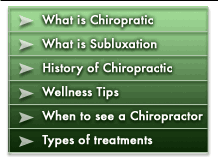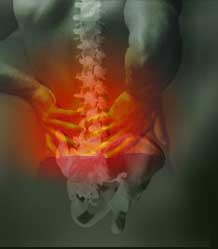 |
 |
|||||
 |
|
 |
 |
 |
|
Types of TreatmentsBelow is a list of some of the common treatment techniques and terminology used in the chiropractic profession. After your initial examination, we will recommend a treatment program during your report of findings. The program may include some of the following treatments. Diversified Diversified Technique is the classic chiropractic technique, developed by D.D. Palmer, DC. and taught in all chiropractic colleges. Diversified Technique was refined and developed by the late Otto Reinert, DC, to address biomechanical failure in each section of the spine, as it relates to specific subluxation. The focus is on restoration to normal biomechanical function, and correction of subluxation. In addition, Diversified methods have been developed to adjust extremity joints, allowing for beneficial applications in treating sports injuries and other injuries. Diversified adjusting of the spine uses specific lines of drives for all manual thrusts, allowing for specificity in correcting mechanical distortions of the spine. X-rays and case histories are used in analysis and diagnosis. No instruments are used in the adjusting procedure. Motion palpatation and full spine, hands-on techniques are used to deliver a deeper thrust, which makes an osseous (popping) sound as the adjustment is given.
Gonstead In the early 1960's word was spreading throughout the world that there was a healer in a small farming community in Wisconsin to whom people of all ages, and walks of life, were flocking. The man was Clarence S. Gonstead. He became a chiropractor in 1923 following a personal experience with chiropractic that had helped his body heal from a painful, crippling episode of rheumatoid arthritis. With a background in mechanical engineering, he would come to apply the principles of this discipline to the evaluation of the spine. Based on his studies, he developed the "foundation principle" to explain how a fixation in one area of the spine created compensatory bio-mechanical changes and symptoms in another. He was a pioneer in the chiropractic profession, developing equipment and a method of analysis that used more than one criteria to verify the precise location of vertebral subluxation (A subluxation is a spinal bone that is fixated or "stuck" resulting in nerve pressure and interfering with the innate ability of the body to maintain health). One hallmark of the Gonstead Technique is adjustment of the neck with a very specific maneuver that is completed with the patient seated. The neck is adjusted in this manner to eliminate the twisting or rotation aspect of the adjusting procedure. The Gonstead Technique is recognized throughout the global chiropractic community as one of the safest systems of evaluating and caring for conditions related to the spine.
Trigger Point Therapy The technique and methods of Trigger Point Therapy were primarily defined and developed by Janet Travell, M.D. Trigger point therapy's primary focus is the elimination of myofascial pain syndrome caused by hyper irritable areas in muscles. Because these pain syndromes are often overlooked, Dr. Travel developed the techniques of trigger point therapy to help patients find relief. Trigger point therapy is performed in several ways. The least invasive is through the application of direct pressure, or ischemic compression to the effected muscle and the trigger point contained therein. Application of a vapocoolant spray in conjunction with stretching of the affected muscle, as well as therapeutic ultrasound may also be used. More invasive methods are available if the myofascial trigger points are unresponsive to the above therapies. Trigger point involves direct pressure to and stretching of the affected musculature. The amount of force used is dependent on patient tolerance. The technique affects the body by eliminating the accumulation of waste in the muscle. Additionally, trigger point therapy allows for restoration of normal muscle tone and flexibility. Trigger points are generally located through physical examination. Additional methods of detection such as thermal imaging are currently being investigated. The technique can be performed with no equipment but often will include the use of a "T.bar" for added pressure, a vapocoolant spray and possibly ultrasound. The technique can be performed on any muscle that develops a myofascial trigger point including extremities and cranial muscles. The Trigger Point Manual by Janet Travell, M.D. and David Simons, M.D. is the definitive text on the subject. Many resources are available on the web through a search for "Myofascial Trigger Points."
Motion Analysis (Palpation) Motion Analysis was brought to the United States in 1981 and quickly gained acceptance as a standard diagnostic tool for the chiropractic profession. Motion palpation is now taught in chiropractic colleges throughout the world. Motion Palpation is a diagnostic technique used by a doctor of chiropractic to locate joint dysfunction within the spinal column and extremities. This method of spinal analysis, also called Motion Analysis, is based upon the conclusion that a vertebra cannot be displaced or remain displaced if some anomaly in the soft tissues (muscles, ligaments, articular capsule, etc.) does not cause and perpetuate its malposition. Therefore a study of the normal and abnormal mobilities of all the vertebral articulations and eventually all the extra spinal points was done to determine whatever anomalies in motion could be found in relation to subluxations. Intimate methods of palpating, and later of measuring mobilities, were developed before and after different adjustments. Motion Analysis/Palpation was created as a system of spinal analysis, which permits an easy examination of the spine, both in pinpointing the different subluxations and in determining their types. This system also serves in determining direction and force of adjustment. It was found that subluxations can be classed according to the degree of restriction of mobility. It was also found that correction of the fixation usually has a spontaneous correcting effect on smaller fixations. Furthermore, when the key fixation in any series is discovered and corrected, there was found to be a series of fixations which usually occured together and disappeared together. Medical diagnosis is used to determine if a subluxation to be adjusted is the site of any pathology. Clinical diagnosis is also necessary to determine if a medical specialist is needed before proceeding with adjustment. Motion Analysis is a comprehensive diagnosis that helps the doctor to apply treatment in the most beneficial way. References: http://www.motionpalpation.org (and) Researchers: H. Gillet, D.C. & M. Liekens, D.C.
Activator Activator is based on the postulate that understanding body mechanics and force is the key to understanding how to move bones. A leg test is utilized to tell the doctor if the subluxation exists, chiefly in the lumbo-sacral area or cervical region of the spine. With further research into body mechanics, W.C. Lee D.C. and A.W. Fuhr D.C. were able to analyze the body and produce from the analysis consistent changes using a light non-force specific chiropractic adjustment. Lee and Fuhr understood that force was not necessary to correct subluxations in the body. Two components are necessary for fast, effective reduction of nerve pressure caused by subluxations. They are speed and line of drive. Speed and line of drive are what make chiropractic the distinct and dynamic art and science that it is. The activator instrument was designed to deliver this specific dynamic thrust. It is a small hand-held gun-type mechanism that delivers a sharp percussive thrust upon triggering. The activator instrument controls the force and speed of the adjustment exceptionally well and with the activator, the line of drive can be more specific. www.activator.com/research.asp
Cox Cox Technique founder, Dr. Cox explains Cox Technique / Flexion-Distraction as a marriage of chiropractic principles with osteopathic principles. These principles were set forth by Alan Stoddard, DO, in his book, 'Manual of Osteopathic Technique' written about the manipulative procedures developed by John McManis, DO, in the early 1900's. Since the early 1970's, Dr. Cox has refined the technique; developed a manipulation instrument for effective use of the technique; conducted clinical, as well as participated in experimental, research; lectured around the world; and written well-received articles, chapters for textbooks, and textbooks. Cox Flexion-Distraction is a gentle, non-force adjusting procedure that works with the body's natural design to aid it in healing. Dr. Cox has developed a special table for effective use of the technique. The Cox Table (www.coxtable.com), a Flexion -Distraction table, is used to apply the distraction spinal manipulation adjustment. What to expect from this technique: Tractioning the spine and then flexing it can resolve pain from joint and disc problems painlessly. It is a powerfully effective, conservative approach to low back and leg pain, and an alternative to explore before recommending surgery. For patients with non-disc related conditions causing back pain (facet syndrome, spondylolisthesis, sprain/strain, scoliosis, transitional vertebra, sacroiliac subluxation, stenosis), Cox Flexion-Distraction provides all of the above benefits plus the ability to place spinal joints into normal movements to restore spinal motion without pain.
Sacro Occipital Technique Sacro Occipital Technique of Chiropractic (SOT) and Chiropractic Craniopathy is grounded in scientific research. Since the early 1900's, SOT has consistently delivered exceptional results while emphasizing patient comfort. SOT is a total body technique. Its broad scope includes not only the back and neck but also the internal organs, extremities and cranial structures. In SOT the primary focus is upon structural stability and integrity as well as neurological function. The basis of the human structure is the pelvis and the cranium. The spine, shoulders, neck and head sit upon the pelvis and are subject to the stresses and strains of gravity. These structures, as well as the rest of the body, are functionally maintained and controlled by the brain through the nervous system. Brain function is dependent upon optimal motion and alignment of the cranial bones and cranial dura. Located below the pelvis is the locomotion system: the legs and feet. All structures of the body are essential to the integrity of the whole. Additionally, organ function depends upon proper nerve supply from the spine. The spine in turn receives nerve reflexes from the organs that can compromise spinal mechanics. Therefore, the alignment, balance and optimal function of the cranium, pelvis, each spinal segment, organs and all of the extremities are essential to optimal health.
|